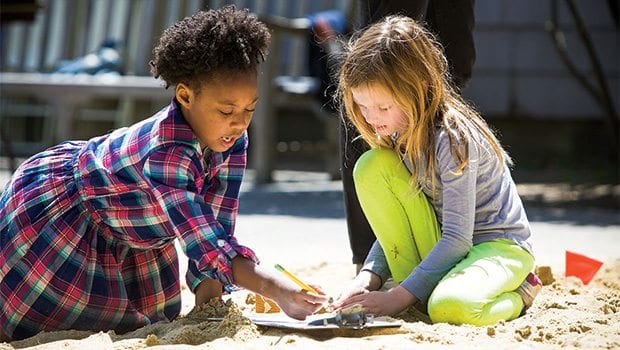Fostering a Diverse, Inclusive Community Is at the Core of Shady Hill School

Set on Coolidge Hill in Cambridge, Shady Hill is an independent elementary school serving about 500 students in pre-kindergarten (age 4) through eighth grade. The School is committed to stewarding a rich, multicultural curriculum and a diverse, inclusive community. As Director of Inclusion and Multicultural Practice, I help lead Shady Hill’s diversity and social justice initiatives. As I start my second year at the School, I am heartened to know I am part of its rich legacy and commitment to diversity and inclusion.
Founded in 1915, Shady Hill was modeled after a school run by Maria Baldwin, a prominent African American educator in the Cambridge area in the early 1900s. When Miss Baldwin’s School closed in 1914, Harvard professor William Ernest Hocking and his wife Agnes O’Reilly Hocking, whose children had been enrolled at Miss Baldwin’s School, took interest in beginning a new school. They established the Cooperative Open Air School, which eventually became Shady Hill School. From the start, Shady Hill distinguished itself as a leader in progressive education and modeled a commitment to diversity.
In the 1950s, while the nation grappled with legal racial segregation during the Civil Rights Movement, Shady Hill welcomed its first African American students. In the following decade, the School began to diversify its faculty as well. Faith Chase, the School’s first African American teacher, was hired in 1969 and taught at Shady Hill until 1992. The School has since established a fellowship in her name that provides funds for current faculty members to attend the People of Color Conference, an annual conference hosted by the National Association of Independent Schools.
As it enters its second century, Shady Hill continues to push toward increased inclusion and racial diversity. One initiative is its collaboration with other area schools to raise the awareness of African-American and Latino families that independent schools are a viable option. Currently, students of color comprise 33 percent of the student body, faculty of color make up 18% of the faculty, and administrators of color comprise 18 percent of the Administrative Team.
While I help to coordinate the School’s diversity initiatives for adults and children, I certainly am not alone in these efforts. This is truly everyone’s responsibility. Through regular professional development, Shady Hill teachers continually work toward improving their practice and fostering a welcoming environment in their classrooms. We launch each school year with a formal session on diversity at our opening faculty meetings and a follow-up session with all new faculty and staff. At this year’s opening meeting, Dr. Ali Michael explored race and identity with the full faculty, based on the work she did for her book, Raising Race Questions. She also worked with leaders in our parent community on the topic of “Building an Inclusive Parent Community.” Another voice for inclusion and multicultural practice on campus is DASH (Diversity at Shady Hill). DASH, which celebrates its thirtieth year this spring, is a group that helps foster parent engagement around issues of equity.
At Shady Hill, we regularly build our faculty’s skills and expand their capacity as culturally competent, multicultural educators. We do this through professional development opportunities that take place throughout the year. We also provide opportunities for formal and informal conversation through faculty discussion groups like the SEED program (Seeking Educational Equity and Diversity). These monthly gatherings open conversations that allow participants to explore their own understanding of issues of diversity.
Our commitment to creating a more socially just world has been a long part of our philosophy and tradition. The School’s reputation and commitment to equity and social justice is part of what attracted me to Shady Hill. The fact that our Head of School Mark Stanek spends time during the summer serving on the faculty of the Diversity Directions Independent School Seminar was a good indicator to me that support for diversity and inclusion efforts at Shady Hill were an institutional commitment at the highest level. As a diversity practitioner, this support is both compelling and critical. More than just symbolic, it is sustaining.
If this sounds like a community that might be right for your family, please come to an Admission Open House. To learn more about Shady Hill, visit our website at www.shs.org. We look forward to meeting you!
— James Greenwood, Director of Inclusion and Multicultural Practice


![Banner [Virtual] Art Gallery](https://baystatebanner.com/wp-content/uploads/2024/04/Cagen-Luse_Men-at-store-e1713991226112-150x150.jpg)



